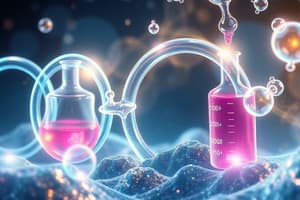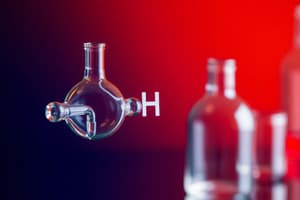Podcast
Questions and Answers
How does the modern definition of an organic compound differ from the early definition?
How does the modern definition of an organic compound differ from the early definition?
- Early definitions were based on the source of the compound, while modern definitions are based on the compound's chemical composition regardless of its source. (correct)
- Early definitions included all carbon-containing compounds, while modern definitions exclude hydrocarbons.
- Early definitions included only compounds synthesized in the lab, while modern definitions include those from living organisms.
- Early definitions included only compounds from mineral constituents, while modern definitions include all non-carbon containing compounds.
Why is carbon able to form a large number of different compounds?
Why is carbon able to form a large number of different compounds?
- Carbon can only form single bonds with predictable linear geometries.
- Carbon is a group IVA element that needs four electrons to complete its valence shell and can form four bonds in combinations that result in predictable geometries. (correct)
- Carbon can only bond with hydrogen to form hydrocarbons.
- Carbon is a group IIA element and only needs two electrons to complete its valence shell.
Which statement accurately describes the difference between saturated and unsaturated hydrocarbons?
Which statement accurately describes the difference between saturated and unsaturated hydrocarbons?
- Saturated hydrocarbons contain only single carbon-carbon bonds, while unsaturated hydrocarbons contain double and/or triple carbon-carbon bonds. (correct)
- Saturated hydrocarbons are cyclic, while unsaturated hydrocarbons are acyclic.
- Saturated hydrocarbons contain double carbon-carbon bonds, while unsaturated hydrocarbons contain single carbon-carbon bonds.
- Saturated hydrocarbons contain only carbon and oxygen, while unsaturated hydrocarbons contain only carbon and hydrogen.
What structural feature differentiates an acyclic alkane from a cyclic alkane?
What structural feature differentiates an acyclic alkane from a cyclic alkane?
Acyclic alkanes have a general formula of $C_nH_{2n+2}$. How is the general formula modified for an acyclic alkane with one double bond?
Acyclic alkanes have a general formula of $C_nH_{2n+2}$. How is the general formula modified for an acyclic alkane with one double bond?
Which of the following statements correctly describes a skeletal structure (carbon chain) representation of an organic molecule?
Which of the following statements correctly describes a skeletal structure (carbon chain) representation of an organic molecule?
What is the key difference between constitutional isomers?
What is the key difference between constitutional isomers?
Which statement best describes conformations of a molecule?
Which statement best describes conformations of a molecule?
What structural feature prevents free rotation in a molecule, leading to different molecules rather than conformations?
What structural feature prevents free rotation in a molecule, leading to different molecules rather than conformations?
In the IUPAC naming system, what is the significance of the suffix 'ane'?
In the IUPAC naming system, what is the significance of the suffix 'ane'?
When naming branched alkanes using IUPAC rules, what is the first step?
When naming branched alkanes using IUPAC rules, what is the first step?
According to IUPAC rules of nomenclature, how should multiple different substituents be listed in the name of an alkane?
According to IUPAC rules of nomenclature, how should multiple different substituents be listed in the name of an alkane?
What is the purpose of using prefixes like di-, tri-, and tetra- when naming alkanes with identical substituents.
What is the purpose of using prefixes like di-, tri-, and tetra- when naming alkanes with identical substituents.
If there is a conflict in numbering when prioritizing the location of substituents, which rule should be followed?
If there is a conflict in numbering when prioritizing the location of substituents, which rule should be followed?
How is a 'sec-' prefix used in naming substituents?
How is a 'sec-' prefix used in naming substituents?
What is the defining characteristic of a primary carbon?
What is the defining characteristic of a primary carbon?
What is the minimum number of carbon atoms required to form a cycloalkane?
What is the minimum number of carbon atoms required to form a cycloalkane?
If a cyclic alkane has two substituents, what determines which carbon in the ring receives the #1 location?
If a cyclic alkane has two substituents, what determines which carbon in the ring receives the #1 location?
What is a defining feature of cis/trans isomers in cycloalkanes?
What is a defining feature of cis/trans isomers in cycloalkanes?
What is the primary structural requirement for a cycloalkane to exhibit cis/trans isomerism?
What is the primary structural requirement for a cycloalkane to exhibit cis/trans isomerism?
Which statement accurately describes the solubility of alkanes in water?
Which statement accurately describes the solubility of alkanes in water?
How does branching affect the boiling points of alkanes?
How does branching affect the boiling points of alkanes?
What is the trend observed in the boiling points of organic compounds as molar mass increases?
What is the trend observed in the boiling points of organic compounds as molar mass increases?
What type of reaction occurs when alkanes react with halogens?
What type of reaction occurs when alkanes react with halogens?
Why do haloalkanes exhibit higher boiling points than similar alkanes?
Why do haloalkanes exhibit higher boiling points than similar alkanes?
Flashcards
Organic Compounds (Early Definition)
Organic Compounds (Early Definition)
Compounds obtained from living organisms.
Inorganic Compounds (Early Definition)
Inorganic Compounds (Early Definition)
Compounds from mineral constituents of the earth.
Organic Compound (Current Definition)
Organic Compound (Current Definition)
Carbon-containing compounds and their derivatives.
Inorganic Compounds (Current Definition)
Inorganic Compounds (Current Definition)
Signup and view all the flashcards
Organic Chemistry
Organic Chemistry
Signup and view all the flashcards
Inorganic Chemistry
Inorganic Chemistry
Signup and view all the flashcards
Why is carbon special?
Why is carbon special?
Signup and view all the flashcards
Hydrocarbon
Hydrocarbon
Signup and view all the flashcards
Saturated Hydrocarbon
Saturated Hydrocarbon
Signup and view all the flashcards
Unsaturated Hydrocarbon
Unsaturated Hydrocarbon
Signup and view all the flashcards
Acyclic Hydrocarbon
Acyclic Hydrocarbon
Signup and view all the flashcards
Cyclic Hydrocarbon
Cyclic Hydrocarbon
Signup and view all the flashcards
Expanded Form (Structural Formula)
Expanded Form (Structural Formula)
Signup and view all the flashcards
Condensed Form (Structural Formula)
Condensed Form (Structural Formula)
Signup and view all the flashcards
Skeletal Structure (Carbon Chain)
Skeletal Structure (Carbon Chain)
Signup and view all the flashcards
Line-Angle Structure (Stick Structure)
Line-Angle Structure (Stick Structure)
Signup and view all the flashcards
Constitutional Isomers
Constitutional Isomers
Signup and view all the flashcards
Conformations
Conformations
Signup and view all the flashcards
IUPAC Naming System
IUPAC Naming System
Signup and view all the flashcards
Parent Chain
Parent Chain
Signup and view all the flashcards
Substituent
Substituent
Signup and view all the flashcards
Cycloalkane
Cycloalkane
Signup and view all the flashcards
Cis/Trans Isomers
Cis/Trans Isomers
Signup and view all the flashcards
Cis
Cis
Signup and view all the flashcards
Trans
Trans
Signup and view all the flashcards
Study Notes
- Alkanes are discussed
Organic vs. Inorganic Compounds
- Early definitions of organic compounds included that they were obtained from living organisms.
- Early definitions of inorganic compounds included that they were obtained from mineral constituents of the earth.
- Current definitions of organic compounds include carbon-containing compounds and their derivatives.
- Current definitions of inorganic compounds include non-carbon containing compounds.
- Organic chemistry is the study of hydrocarbons and their derivatives.
- There are approximately 7 million known organic compounds.
- Organic compounds are no longer derived from living organisms.
- Organic compounds are synthesized in the lab.
- Inorganic chemistry is the study of all other compounds except hydrocarbons and their derivatives.
- There are approximately 1.5 million known inorganic compounds.
- The ratio of organic to inorganic compounds is almost 5:1.
Carbon's Special Properties
- Carbon can make a large number of different compounds.
- Carbon is a Group IVA element.
- Carbon needs 4 electrons for a full valence shell.
- Carbon must have 4 bonds.
- Carbon can make 4 bonds with predictable geometries
- Combinations include, 4 single bonds (Tetrahedral geometry), 2 single + 1 double bonds (Trigonal planar geometry), 2 double bonds (Linear geometry), and 1 single + 1 triple (Linear geometry).
- Carbon can bond with other carbons to form long chains and ring structures
Hydrocarbons
- Hydrocarbons contain carbon and hydrogen only.
- There are two classes: saturated and unsaturated.
- Saturated hydrocarbons contain only single carbon-carbon bonds.
- The general formula for acyclic alkanes is CnH(2n+2).
- Unsaturated hydrocarbons contain double and/or triple carbon-carbon bonds.
- For every double bond, lose 2 hydrogens.
- For every triple bond, lose 4 hydrogens.
- Acyclic hydrocarbons have all carbons linked in a single chain, can be linear or branched.
- Cyclic hydrocarbons have carbon atoms bonded, forming a ring structure.
- For cyclic structures, the general formula loses 2 hydrogens.
Drawing Structures
- Structural formulas give information on how the atoms are connected in the molecule.
- Expanded form shows all elements and all bonds.
- Condensed form shows atom groupings, which are related to specific connection patterns.
- Skeletal structure or carbon chain shows only carbon atoms with no other elements.
- It is understood that carbon will have a total of 4 bonds
- Missing bonds are filled with hydrogens to make 4 bonds to each carbon.
- Line-angle structure or stick structure uses lines as the bonds between carbon atoms and carbon atoms are the connection points.
- The number of hydrogen atoms will give each carbon 4 bonds total.
- All other elements are shown in the structure.
- Expanded form shows the connectivity for all atoms in the molecule and the bond types connecting the elements.
Constitutional Isomers
- Constitutional isomers are different compounds with the same chemical formula, but the atoms are connected differently.
- Constitutional isomers have the same chemical formula.
- There is more than one structural formula.
- Constitutional isomerism begins with C4H10 structures and increases from there.
- The number of isomers grows exponentially as the number of carbon atoms in the molecule increases.
Conformations
- Conformations are the specific 3-D arrangement of atoms in a molecule resulting from free rotation about a carbon-carbon single bond.
- Free rotation gives rise to multiple shapes of the carbon chain.
- Different conformations represent the same molecule.
- Free rotation does not occur with double or triple bonds.
Naming Alkanes
- Molecules might have multiple names, but they are named according to IUPAC.
- There are common names to become familiar with.
- The IUPAC naming system is a method for naming all organic compounds.
- Knowledge of this system builds as the semester progresses.
- Suffix for Alkanes is "ane" as they are saturated hydrocarbons
- To name straight chain alkanes, know how many carbons are linked in a single chain.
IUPAC Naming Rules for branched alkanes
- Find the longest carbon chain
- Identify branching points
- Identify the substituents (branches)
- Find the number of carbons in each branch
- Give the substituent the lowest number location or number combination
- If you cannot distinguish, then prioritize alphabetically
- List alphabetically in name
IUPAC naming format
- All Substituents - parent chain - family name ending
- Substituent location and name
- Substituent location and name separated by a dash
- If more than one substituent
- List alphabetically
- If substituents are the same
- Use prefixes di, tri tetra... to indicate how many substituents are the same
- Prefixes not used when alphabetizing
- List each location number and separate location numbers with commas
- Parent chain – how many carbons
- Family name ending – “ane” for alkanes
Carbon Classifications
- Primary (1°) - bonded to one other carbon; other bonds are to hydrogen, usually found at chain end, CH3 group
- Secondary (2°) - bonded to two other carbons; other bonds are to hydrogen, CH2 group
- Tertiary (3°) - bonded to three other carbons; other bond is to hydrogen, CH group
- Quaternary (4°) - bonded to four other carbons, no bonds to hydrogen
Cycloalkanes
- Cycloalkanes = cyclic compounds
- Cycloalkanes - a saturated hydrocarbon with a ring structure (cyclic arrangement)
- Minimum number of carbons = 3, range is between 3-30
- General formula for cycloalkanes: CnH2n
- General formula for acyclic alkanes: CnH2n+2
- Tetrahedral geometry = 109.5
- IUPAC Naming guidelines are the same as naming straight and branched chain alkanes
- The parent chain uses the number of carbons in the ring structure
- Substituent location number depends on the number of substituents
- 1 substituent - no # needed
- If no C#1 in a circle, it's understood that the substituent is C#1
- 2 substituents - alphabetical priority determines C#1
- Numbering of Carbons follows in the direction to give the lowest location numbers to the other substituent
- 3 or more substituents - lowest number combination or if needed use alphabetical priority
- 1 substituent - no # needed
- If no C#1 in a circle, it's understood that the substituent is C#1
- 2 substituents - alphabetical priority determines C#1
Cycloalkanes Isomers have Two Types
- Constitutional isomers - same chemical formula but connectivity of atoms is different
- Cis/Trans isomers - the same chemical formula with same connectivity, but different 3-D arrangement in space
- Because the carbon atoms are held in a fixed location
- The carbon atoms or groups of atoms attached to those in the ring will have a set configuration based on their attachment - Creates a top and bottom in the structure These are called stereoisomers
- Cis - substituents on the same side of the ring.
- Trans - substituents on opposite sides of the ring
Occurs in rings of all sizes
Requires 2 substituents on 2 different carbons
Substituents do not need to be the same
Biochemically important
This nomenclature is limited to ring structures that contain one hydrogen and one substituent on the substituted carbon atoms
- More complicated systems use E,Z nomenclature system
Properties of Alkanes
- Insoluble in water because alkanes are nonpolar
- Hydrocarbons are nonpolar
- Density is less than water -Range from 0.6 – 0.8 g/mL Float on top of water=
- Boiling points
- Lowest boiling points an melting points
- Phases at room temps-
- C1 - C4 are gases -C5 – C17 liquids -C17 solids
- Molar mass increases means the boiling point increases.
- Branched alkanes, have lower boiling point because decreased surface area contact
- Cycloalkanes, have higher boiling points compared to that of straight alkanes because better packing
Reactions of Alkanes, involves 2 types
- Combustion w/ O2 and Halogenation w/ Halogens are major reactions
- Lower reactivity than other classes of organic compounds
- Combustion reaction produces carbon dioxide and water.
- General reaction: 2 C2H6 + 7 O2 -> 4 CO2 + 6 H2O -Product of incomplete combustion is Carbon Monoxide
- Halogenation Reaction, incorporates a halogen atom( F, Cl, Br or I ) into a molecule
Substitution reaction – removing an atom or group of atoms to replace it with other
For alkanes, Hydrogen atoms have being replaced w/ halogen in its reaction
The general reaction is: R-CH3 + X₂ -> R-CH₂X + HX (Heat/light & catalyst required).
- R = rest of molecule & X = halogen atom
- Which can be H, methyl group, ethyl group -H alogenation reaction forms a mixture of products. Not limited to remove specificity of hydrogen atoms,Any hydrogens removed. . , Major product/s from (major prod based on stoichiometric, so still mix)
- R = rest of molecule & X = halogen atom
Naming Halogenated Alkanes:
- Rules are the same as for other alkanes
- Halogen is a substituent
- Prioritized like other alkyl substituents
- Location number or alphabetical
- Substituent names for halogens • fluoro = F • chloro = Cl • bromo = Br • iodo = I
Properties of Halogenated Alkanes
- Higher Boiling Points from Alkanes
- CX bond is polar, making Dipole - induced dipole stronger than the London Dispersion Forces that Hydrocarbons exhibit
- Higher Densities from Alkanes
- Halogens have a higher atomic mass than carbons
- Haloalkanes w/ >2 Chlorines, Bromines, or Iodine have a greater density than water
Studying That Suits You
Use AI to generate personalized quizzes and flashcards to suit your learning preferences.




